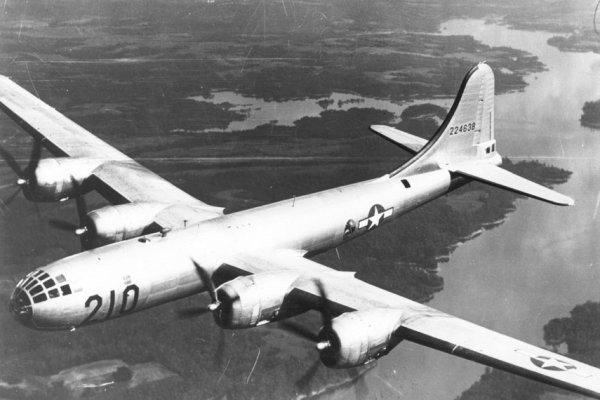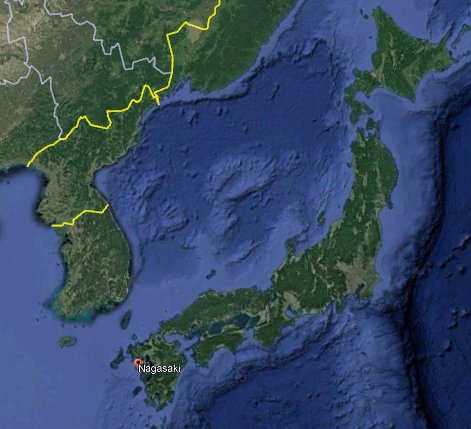ACUFO-1944-08-10-NAGASAKI-1
In 1999, US ufologist Jan Aldrich noted in a catalogue of his historical ufology Website Project 1947 that on August 10, 1944 at night, over Japan, two B-29 aircraft crews of the 40th Bombardment Group reported seeing a green flare followed by an amber-orange flash horizontally across the nose of the aircraft; whereas there were no fighters, or searchlights on this mission and flak was meager.
Aldrich indicated that this appeared in the “40th Bomb Sq History”.
I was able to read this source, a document by the Historical Officer of the 40th Bombardment Group for events from August 1, 1944, to August 31, 1944; which allows me to add that the location was Nagasaki.
The report also told that during this raid, there were no searchlights nor fighter opposition in the target area, meager anti-aircraft activity with no damage or hits being sustained by the B-29's, that despite this reported sighting, “It cannot be substantiated, however that any enemy planes were in the vicinity” and that “No barrage balloons were reported in the area and no smoke screens were observed.”
(This was the first bomb raid over Japan since Doolittle's B-24's exploit in 1942 so obviously Japanese defenses were not quite ready).
| Date: | August 10, 1944 |
|---|---|
| Time: | Night. |
| Duration: | ? |
| First known report date: | 1945 |
| Reporting delay: | Hours, years. |
| Country: | Japan |
|---|---|
| State/Department: | Nagasaki |
| City or place: | Nagasaki |
| Number of alleged witnesses: | Several in 2 groups. |
|---|---|
| Number of known witnesses: | ? |
| Number of named witnesses: | 0 |
| Reporting channel: | Military historical report. |
|---|---|
| Visibility conditions: | Night. |
| UFO observed: | ? |
| UFO arrival observed: | ? |
| UFO departure observed: | ? |
| UFO action: | In the air in front of aircraft. |
| Witnesses action: | |
| Photographs: | No. |
| Sketch(s) by witness(es): | No. |
| Sketch(es) approved by witness(es): | No. |
| Witness(es) feelings: | ? |
| Witnesses interpretation: | ? |
| Sensors: |
[X] Visual: 2 crews.
[ ] Airborne radar: [ ] Directional ground radar: [ ] Height finder ground radar: [ ] Photo: [ ] Film/video: [ ] EM Effects: [ ] Failures: [ ] Damages: |
|---|---|
| Hynek: | NL |
| Armed / unarmed: | Armed, 12 Browning M2 12,7 mm machine guns. |
| Reliability 1-3: | 3 |
| Strangeness 1-3: | 2 |
| ACUFO: | Insufficient information, possible meteor. |
[Ref. aaf1:] 40TH BOMBARDMENT GROUP HISTORY, U.S. ARMY AIR FORCES:
Following the departure of the fourteen B-29's for China Bay on 8 Aug [1944] all the remaining B-29's that were in commission at Chakulia proceeded to A-1 to make up a striking force for an attack on the city of NAGASAKI.
[...]
A-1, on 8 Aug 44, 4 planes were dispatched from the Rear, 3 of these arrived at the Forward Area and one plane returned to the Rear due to engine trouble. On 9 Aug 44, 2 planes arrived at the Forward Area and on 10 Aug 44 the last of 8 dispatched arrived. On 10 Aug 44 a total of 7 B-29 aircraft were airborne for the assigned mission. One plane was unable to take off due to it being delayed at the Rear because of mechanical difficulties. The first aircraft took off at 0902 Z and the last at 0931 Z. A short time after take off - plane #503 developed engine trouble and returned to the field at 1008 Z. The trouble was remedied and the plane took off again at 10471/2 Z. Plane #298 returned to A-1 at 1020 Z due to an oil leak in #2 engine.
[...]
There were no searchlights nor fighter opposition in the target area. AA was meager with no damage or hits being sustained by our aircraft. Two planes reported seeing a green flare followed by an amber-orange tail flash across the nose of the plane horizontally and at the same level as the plane. It cannot be substantiated, however that any enemy planes were in the vicinity.
No barrage balloons were reported in the area and no smoke screens were observed. Blackout was poor on the entire Island of KYUSHU, and a majority of the crews felt the enemy had made no attempt to black out the area.
[...]
I show relevant extracts here, not the entire report. See References for a link to the full report.
[Ref. prt1:] JAN ALDRICH - "PROJECT 1947":

|
*N 1944.08.10 - Night, Japan
B-29, 40th Bombardment Group, two aircraft crews reported seeing a green flare followed by an amber-orange flash horizontally across the nose of the aircraft. (There were no fighters, or searchlights on this mission and flak was meager. 40th Bomb Sq History)
[Ref. dwn2:] DOMINIQUE WEINSTEIN:
At night the crews of two B-29s from the 40th Bombardment group observed a green flare followed by an amber-orange flash horizontally across the nose of the aircraft.
Sources: List of Cases prior to 1947, Jan Aldrich / Uninvited Guests, Richard Hall, 1988, p.198 / UFO Encyclopedia volume 2, Jerome Clark
The Boeing B-29 “Superfortress” was the heaviest bomber of the U.S. Army Air Forces, used in operations from May 8, 1944 and on. Its maximum speed was 574 km/h.
Its defensive armament was 12 Browning M2 12.7 mm machine guns.

|

|
(See www.40thbombgroup.org)
The 40th Bombardment Group (Medium) was constituded on November 22, 1940; it was redesignated 40th Bombardment Group (Heavy) in May 1942, redesignated 40th Bombardment Group (Very Heavy) in November 1943. After training with B-29's, moved to India, via Africa, on March - June 1944. It was assigned to Twentieth Air Force in June 1944. On June 15, 1944, it participated in the first Army Air Forces attack on Japan since the Doolittle raid in 1942. Operating from bases in India, such as Chakulia, at times staging through fields in China, the Group struck transportation centers, naval installations, iron works, and aircraft plants in Burma, Thailand, China, Japan, Indonesia, and Formosa, receiving a Distinguished Unit Citation for bombing iron and steel works at Yawata, Japan, on August 20, 1944.
On August 10, 1944, it bombed both Palembang in Malaysia and Nagasaki in Japan.
The 40th Bombardment Group (Very Heavy) should not be confused with the 40th Expeditionary Bomb Squadron, also using B-29, but deployed to Tinian, Mariana Islands in December 1944.
Note: there was another much more detailed observation by the same unit on the same day during the attack on Palembang in Malaysia.
It is very difficult for me to asses this observation; a lot of information is missing, such as the duration, and how the observation ended.
It is not impossible, for example, that it was a meteor.
Insufficient information, possible meteor.
* = Source is available to me.
? = Source I am told about but could not get so far. Help needed.
| Main author: | Patrick Gross |
|---|---|
| Contributors: | None |
| Reviewers: | None |
| Editor: | Patrick Gross |
| Version: | Create/changed by: | Date: | Description: |
|---|---|---|---|
| 0.1 | Patrick Gross | December 9, 2023 | Creation, [aaf1], [prt1]. |
| 1.0 | Patrick Gross | December 9, 2023 | First published. |
| 1.1 | Patrick Gross | December 28, 2023 | Addition [dwn2]. |